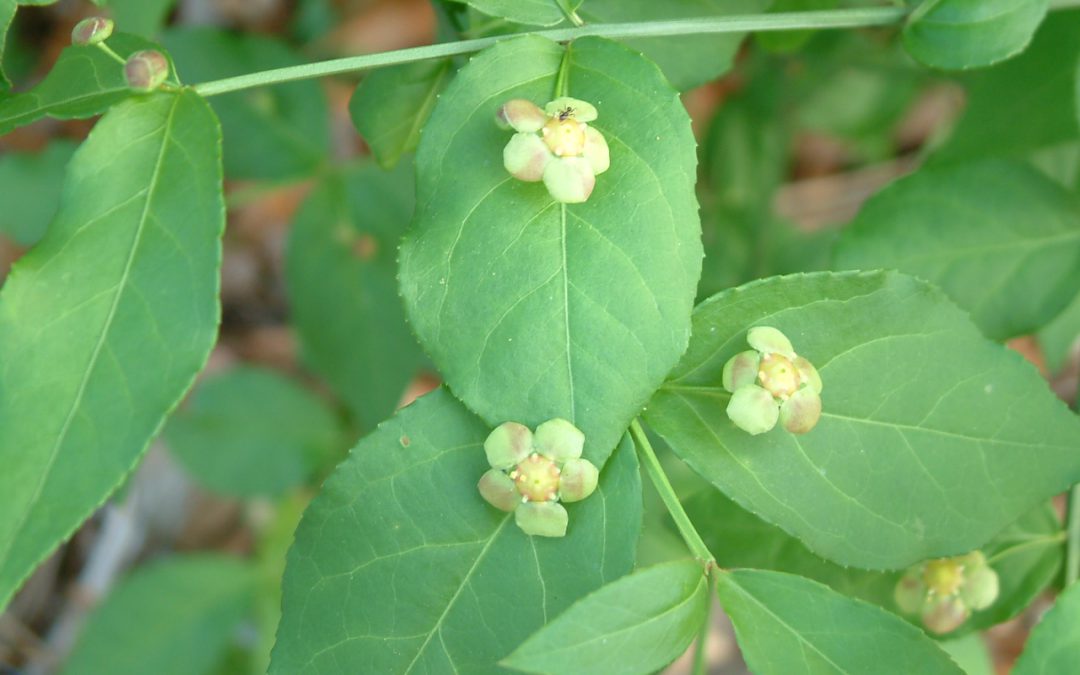
by Beth Bolles | Apr 28, 2022
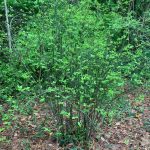
Strawberry bush with new spring growth. Photo by Beth Bolles, UF IFAS Extension Escambia County.
When I was first planting a landscape in 2001, I wanted to include some interesting native plants to provide a natural look for the back edges of the property. I was able to find a few less commonly sold natives from a small local nursery including a Bigleaf magnolia, Vaccinium, Sourwood, Cinnamon fern, and Strawberry bush.
Twenty years later, I am still enjoying these natives in my landscape and they are doing well despite my sandy, well drained, nutrient poor conditions. One of my favorites of this group is the Strawberry bush, Euonymous americana.
Strawberry bush is a deciduous shrub that grows about five feet tall. It has multiple stems with new stems forming each season. Since my yard is so dry, my clump is by no means out of bounds after 20 years of growth. Small pale green flowers grow from the nodes in spring. For most of the year, you forget about this plant until one day in the fall, you notice brilliant red fruits that split open to show orange seeds. Another common name is Hearts-a-bustin’.
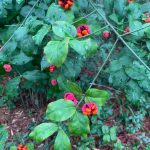
Fall color with Strawberry bush. Photo by Beth Bolles, UF IFAS Extension Escambia County.
Despite one of its common names, Strawberry bush is not grown as an edible for people but serves as a wildlife food source. Deer may enjoy leaves and twigs and many birds and small mammals will eat the seeds.
If you find a local nursery that is growing a few, consider adding Strawberry bush to a shaded spot in your landscape.
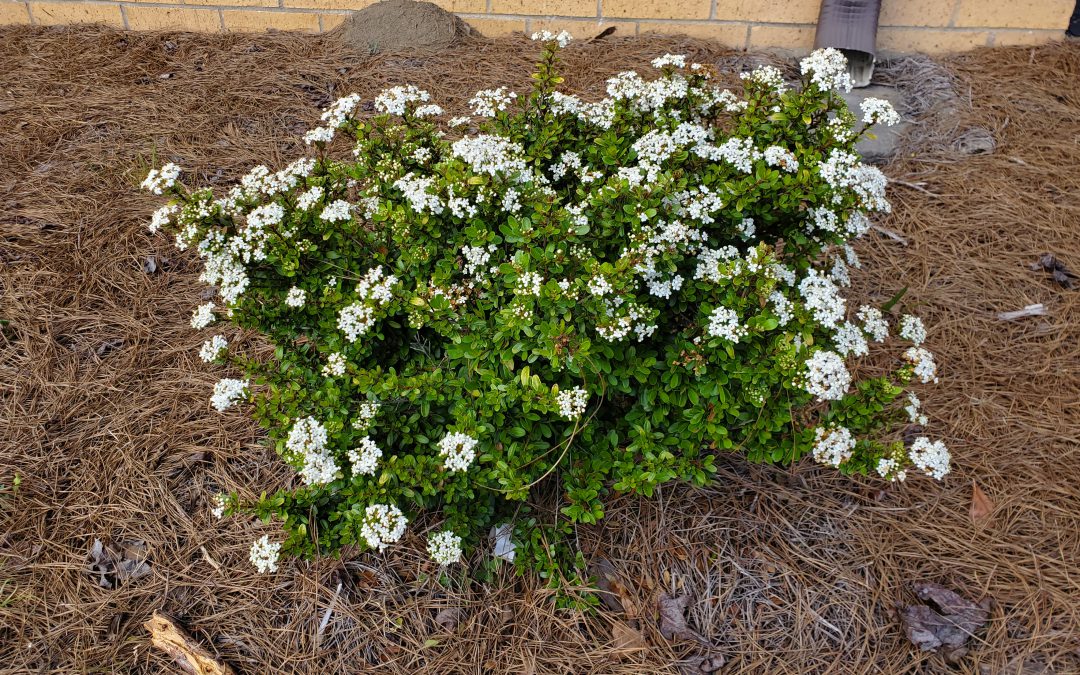
by Daniel J. Leonard | Apr 14, 2022
Lost in the sea of more popular and showy spring-flowering landscape shrubs like azalea, spirea, and the like, is an underused, exceedingly tough, and currently flowering Florida native shrub that is deserving of a spot in your landscape, Walter’s Viburnum (Viburnum obovatum).
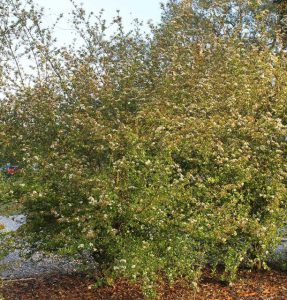
Species Walter’s Viburnum (Viburnum obovatum). Photo Credit: UF/IFAS.
Walter’s Viburnum, named for English-born botanist turned South Carolina farmer Thomas Walter, who first described the species in the late 1700’s, is a spring-flowering mostly evergreen shrub/small tree native to the Southeastern United States. In its native environment around hammocks, swamp edges, and near-river forests beneath the understory of canopy trees, Walter’s specimens often grow to around 15’ in height, live for more than 50 years, and spread slowly into loose thickets from their extensive underground root system. After covering themselves in clusters of small, showy, pollinator-attracting white flowers in spring, Walter’s produces small reddish-black fruit that are magnets for birds and other small wildlife in summer.
Though this tough, low-maintenance nature and gorgeous pure white March flower display should have seemingly enabled Walter’s to be a standout in the landscape, Walter’s Viburnum languished in popularity for many years as it didn’t fit into most landscapes in its wild form. Not too many folks in modern landscape situations are looking for a thicket forming, unkempt-looking tree! However, with increased breeding efforts aimed at selecting superior dwarf varieties and the rise in interest in using low-maintenance native plants, Walter’s has rapidly gained market share on traditional flowering shrubs in nurseries and yards in across Florida.
These newer dwarf varieties of Walter’s, including standouts like ‘Mrs. Schiller’s Delight’ and my personal favorite ‘Whorled Class’, only grow 3-4’ in height and make an excellent replacement for more commonly planted small foundation shrubs. Why plant a disease-prone Boxwood when you can have a disease-resistant native dwarf Walter’s Viburnum? Why allow your landscape to be saddled with drab Dwarf Yaupon Holly when you could get the same basic effect AND an awesome flower show by planting a dwarf Walter’s? Tired of having to constantly prune those Loropetalum or Azaleas to keep them from hiding the house? I think you know the answer by now; plant a slow-growing dwarf Walter’s!
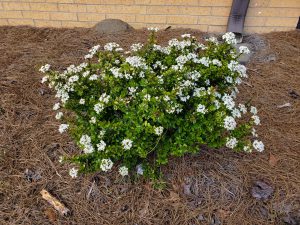
‘Whorled Class’ dwarf Walter’s Viburnum in a Calhoun County, FL landscape. Photo Credit: Daniel Leonard, University of Florida/IFAS Extension – Calhoun County.
Both the “wild-type” Walter’s Viburnum and the newer dwarf cultivars are about as low maintenance landscape shrubs as one could want. Though Walter’s normally occurs in shaded understory situations with moist, acidic soils in the wild, it is very adaptable to all manner of landscape situations. The species takes full sun extremely well but will also thrive with shade. It will tolerate very moist soil but, once established, is drought tolerant. I fertilize my Walter’s plants each spring with a general purpose, balanced garden fertilizer to boost growth, but there are many plantings of the species that get by without supplemental fertilizer. Finally, due to the dwarfing nature of the previously mentioned Walter’s cultivars, constant shearing won’t be necessary to maintain a pleasing shape, but they do respond well to pruning when a haircut is needed!
If you’ve been looking to include something a little bit different from the standard spring flowering fare in your landscape but also require your plants to be tough adaptable, try Walter’s Viburnum, especially the cultivars ‘Whorled Class’ or ‘Mrs. Schiller’s Delight’. They’ll be attractive, low-maintenance additions to nearly any Panhandle landscape for years to come! For more information about Walter’s Viburnum or any other horticultural or agricultural topic, contact your local UF/IFAS County Extension office. Happy gardening!
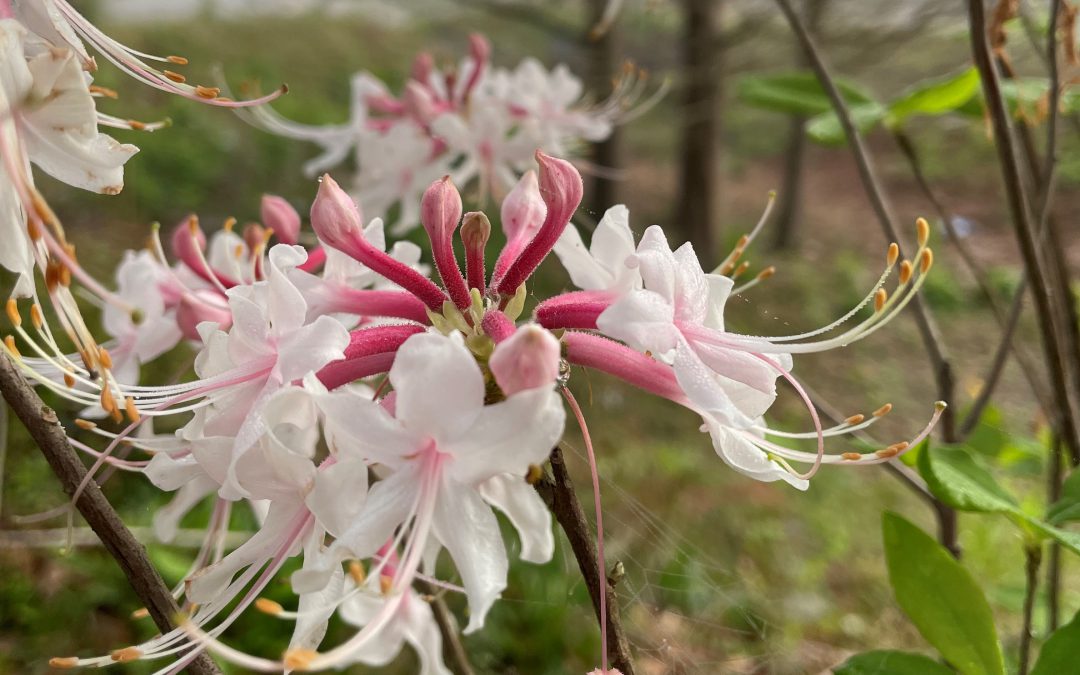
by Matt Lollar | Mar 31, 2022
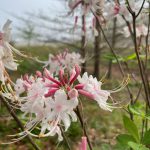
Piedmont azalea (Rhododendron canescens) flowers. Photo Credit: Matt Lollar, University of Florida/IFAS Extension – Santa Rosa County
Native azaleas are stunning this time of year. These deciduous shrubs (and sometimes small trees) often go unnoticed until they bloom in the spring. Three species native to Florida are the piedmont azalea (Rhododendron canescens), the Florida flame azalea (Rhododendron austrinum), and the swamp azalea (Rhododendron viscosum). Piedmont azaleas have whitish to pinkish blooms, Florida flame azaleas have yellow to orange blooms, and the white blooms. All three species have a wonderful honeysuckle-like, sweet fragrance. All three serve as outstanding focal points in the landscape.
Native azaleas and other deciduous azaleas have varying site preferences. Like other azaleas, piedmont and Florida flame azaleas prefer moist, well-drained, acidic soils. However, as the name would suggest, the swamp azalea tolerates wetter locations. All three species prefer partial shade (morning sun and afternoon shade are best) locations and can grow up to 15 feet tall.
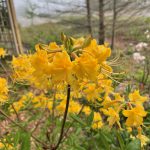
Rhododendron x ‘Aromi Sunny-Side-Up’ in bloom. Photo Credit: Matt Lollar, University of Florida/IFAS Extension – Santa Rosa County
In addition to these beautiful native azaleas, a number of deciduous hybrids have been developed. Aromi hybrids have been bred to tolerate heat and humidity. These azaleas were developed from four native species ()from Gene Aromi in Mobile, AL. He developed more than 100 cultivated varieties (also referred to as cultivars). Popular cultivars in the market include ‘Centerpiece’, ‘Aromi Sunrise’, and ‘Aromi Sunny-Side-Up’.
Deciduous azaleas do not require a lot of fertilizer. A controlled release or slow release, acid forming (specifically formulated for azaleas or blueberries) fertilizer is recommended. A fertilizer nutrient ratio of or close to 2-1-1 (N-P-K) should be selected. Plants should be fertilized in spring or early summer, never in the fall or winter.
More information on azales, native and nonnative, can be found on the UF/IFAS Gardening Solutions website.
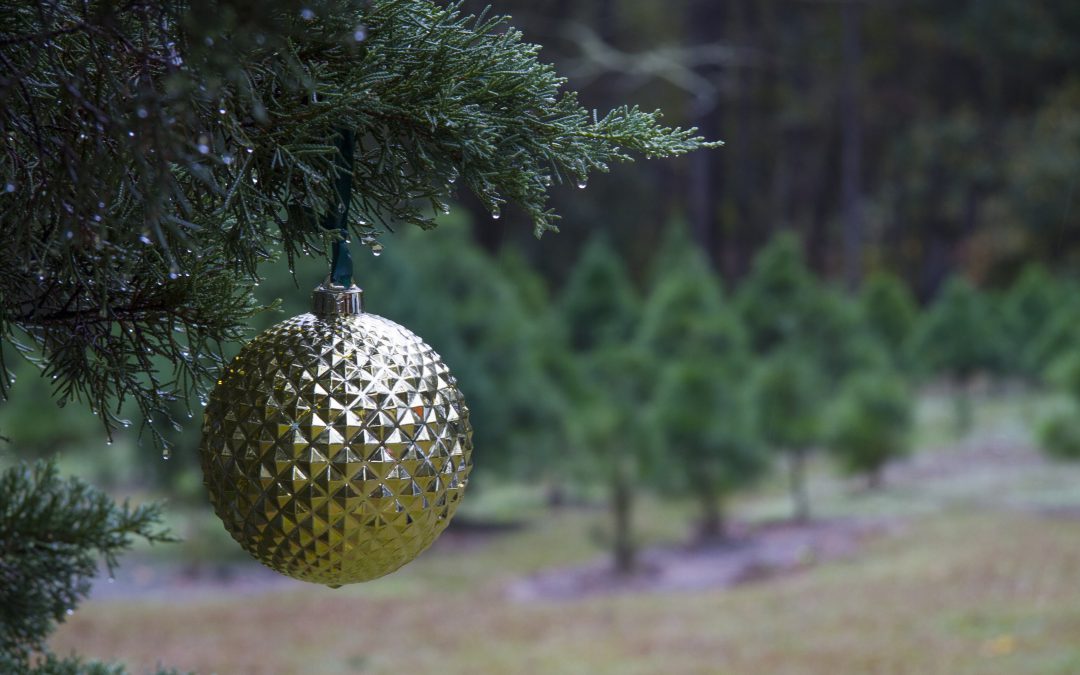
by Daniel J. Leonard | Dec 31, 2021
Christmas is among my favorite holidays. The religious significance, music, lights, amazing food, fellowship with family, and giving and receiving gifts all lend something special to the season. However, the tradition that arguably gets the most attention is selecting and putting up a Christmas tree! Those that participate in the festivities and put up a Christmas tree have three options: purchasing an artificial tree, purchasing a real tree, or growing your own.
While I like the convenience of a pre-lit tree as much as anyone, artificial trees don’t do a whole lot for the environment or sustainable US agriculture. They are almost exclusively produced overseas and contain non-biodegradable plastics. Not the best. If you select option two and choose to purchase a real tree, you’ll help support a sustainable US agriculture industry! According to the National Christmas Tree Association, there are ~25-30 million Christmas trees sold annually in the US and 350 million more currently growing on Christmas tree farms waiting their turn! Purchasing real Christmas trees also ensures that the over 100,000 Christmas tree farm workers remain employed, and the 1/3 million acres US Christmas tree farms comprise will remain non-developed “green spaces”!
But for the green-thumbed Christmas enthusiast that’s willing to put in a little time and effort, there is a third choice – growing your very own Christmas tree right at home! In the Panhandle, there are several species, Florida natives and not, that make wonderful Christmas trees and are easy to grow!
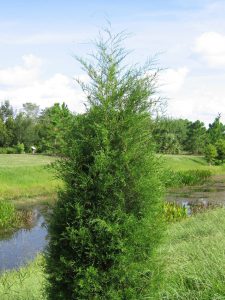
Red Cedar makes a fine Florida Christmas tree!
Red Cedar (Juniperus virginiana) – This Florida native is the classic southern evergreen. Growing quickly to the desired heights of 4’-10’, emitting a “Christmas tree smell”, and possessing dark, dense foliage, Red Cedar makes an excellent Christmas tree! Red Cedar performs very well in most soils but does not like wet feet and will not tolerate continuously saturated areas.
Leyland Cypress (x Cupressocyparis leylandii) – A hybrid of Alaskan Cedar and Monterrey Cypress, Leyland Cypress is recognized as one of the most popular Deep South grown Christmas trees for good reason. Leylands grow exceptionally fast, are a desirable forest green color, and have a naturally conical shape! Though not recommended as long-term landscape trees in Florida due to disease susceptibility, Leylands do very well in short Christmas tree rotations.
Thuja ‘Green Giant’ – ‘Green Giant’ is a cultivar of Thuja and is similar in appearance to Leyland Cypress. Though not quite as deep green in color as Leyland, ‘Green Giant’ also grows rapidly (up to 3’-4’ annually), tolerates many soil conditions, and has no serious insect/disease issues.
Arizona Cypress (Cupressus arizonica var. arizonica) – Arizona Cypress is the Christmas tree for those who would normally choose to be different by purchasing a blue, silver, or white artificial tree! Famous for its striking blue/silver foliage, Arizona Cypress is native to the American Southwest but thrives in the drier sandy soils found in many parts of the Panhandle.
Sand Pine (Pinus clausa) – The quintessential “Cracker Christmas Tree”, Sand Pine is native to the deep sandy ridges of Florida. Normally thought of as a scrubby, low-value tree, when shaped a little, the short-needled Sand Pine makes an excellent Christmas tree! Obviously preferring a dry, sandy site but capable of growing nearly anywhere, Sand Pine has no pest or disease issues and grows fast! If you want a true, old-school Florida Christmas tree, Sand Pine is it.
Regardless of the species you choose, implementing the following few maintenance tips and expectations will lend best results:
- Cut/remove J or circling roots before planting.
- Plant just higher than ground level.
- Refill the hole with native soil from the site.
- Regular irrigation for the first several months of their lives is necessary and trees will benefit from supplemental fertilizer applications twice a year (spring and mid-summer).
- Shaping trees each summer with hedge shears to achieve the desired dense, compact shape will allow for a uniform tree with no “holes”.
- Plant several trees per year to ensure a nice tree come December, just in case.
- Florida grown Christmas trees will NOT have the exact look of fir or spruce. Adjust expectations accordingly.
- Most Florida grown Christmas trees do NOT have rigid branches and cannot support heavy ornaments. Again, adjust expectations accordingly.
While Christmas tree species that perform well in the Panhandle will not have the exact look of a classic fir or spruce sourced from the Carolinas, they certainly mimic the look and there is something to be said for walking outside and harvesting your own tree to put presents under! For more information on growing your own Christmas trees or other horticultural topics, contact your local UF/IFAS County Extension office! Happy New Year!
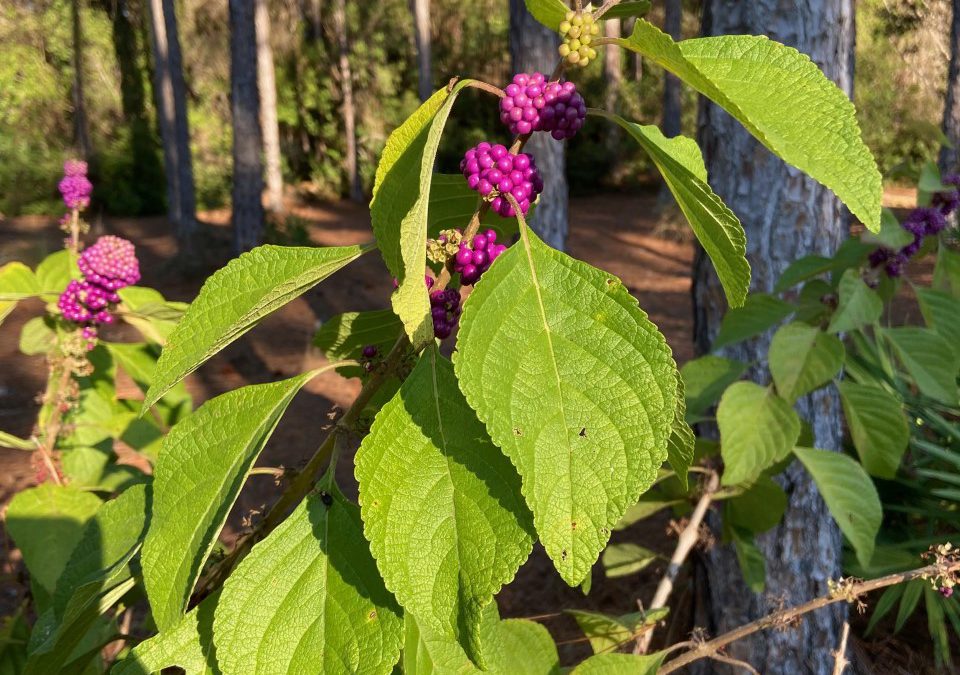
by Stephen Greer | Nov 4, 2021
Many of the native plants in the Northwest Panhandle of Florida are often placed into landscapes as backdrop support plants. Many bring the solid green color to emphasis other colorful plants. What is often missed is the opportunity to see the fall color palate of these plants. Sometimes the easiest thing to do is travel to the nearest nursery to purchase annuals and perennials that come from all over the world and have been time tested to determine their invasiveness outside of planting areas and are determined to be at a minimal risk of colonizing outside of their intended planting area.
Native plants may not be in the thought process and are often overlooked for their exceptional color that can be a focal point in the landscape. Several native plants bring multi-colored leaves or flowers adding fall interest for all to enjoy. Let us take a moment and look at just a few of the plants that can be found in the Florida Panhandle that offer the many colors you may be looking to utilize in your landscape.
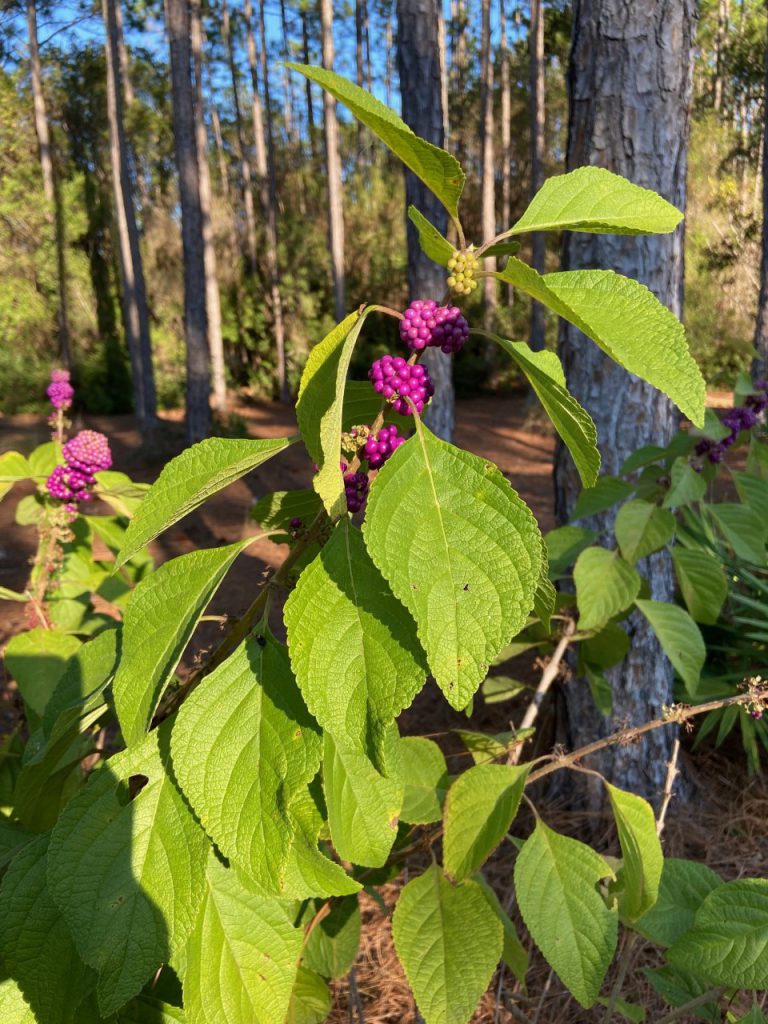
American Beautyberry (Callicarpa americana). Photo courtesy: Stephen Greer, University of Florida/IFAS Extension – Santa Rosa County
American Beautyberry
Beautyberry has two wonderful display times each year. In the late spring to early summer petite light colored lavender flowers open in small clusters along the upright stems of the plant. This flowering can be a brief soft show for a few weeks. The big color show comes in the fall with colorful shiny purple fruit clusters known as drupes. The fruit clusters around the stems of the plant in groups of 20 plus drupes. Often you will see multiple clusters on a given stem spaced approximately 3 to 4 inches apart in the beside the leaf petiole area.
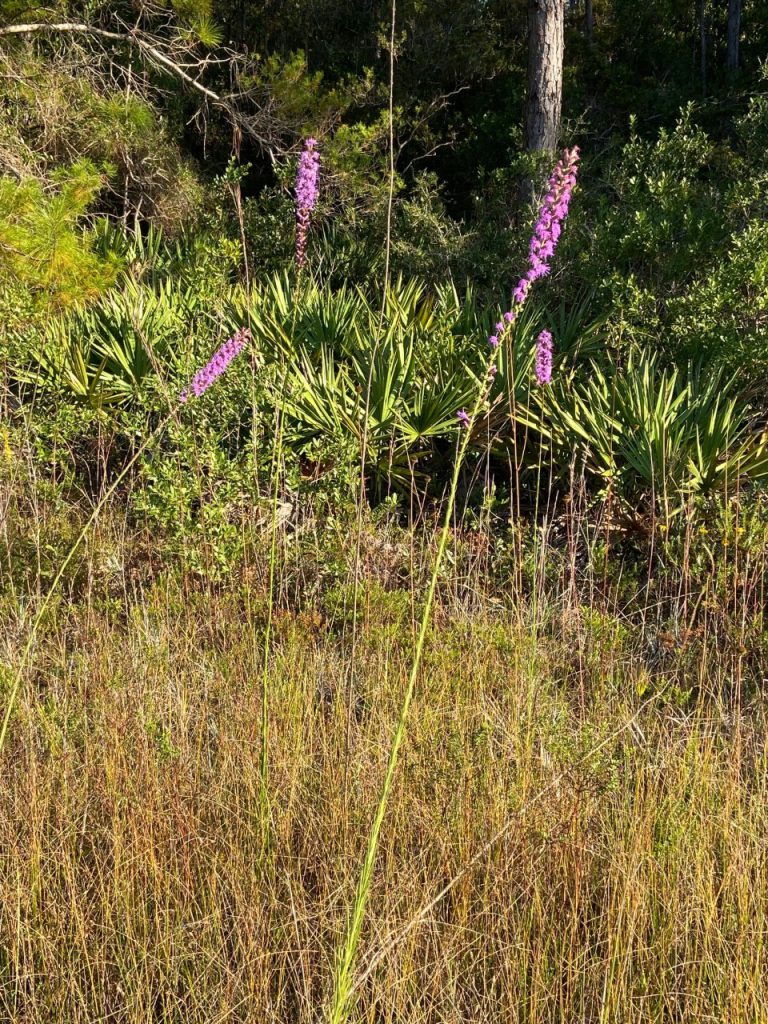
Blazing Star (Liatri spicata). Photo courtesy: Stephen Greer, University of Florida/IFAS Extension – Santa Rosa County
Blazing Star
Blazing star is another fall beauty that creates a great vertical flower floret display of tall spires showing a pleasant medium lavender color. The clustered small flowers provide color in the garden for several weeks. This pollinator plant attacks Monarchs and Swallowtails butterflies plus others adding more enjoyment to the garden. For quality establishment and growth, it needs well drained soil, yet soils that are not high in fertility. Overly fertile soils will over stimulate flower stem growth that will grow too tall and flop over. Blazing star can be divided once it is established and has expanded through underground stem growth creating a wider plant base. In sandy soil sites that have been disturbed through clearing this plant will often establish through seed from adjacent plant settings.
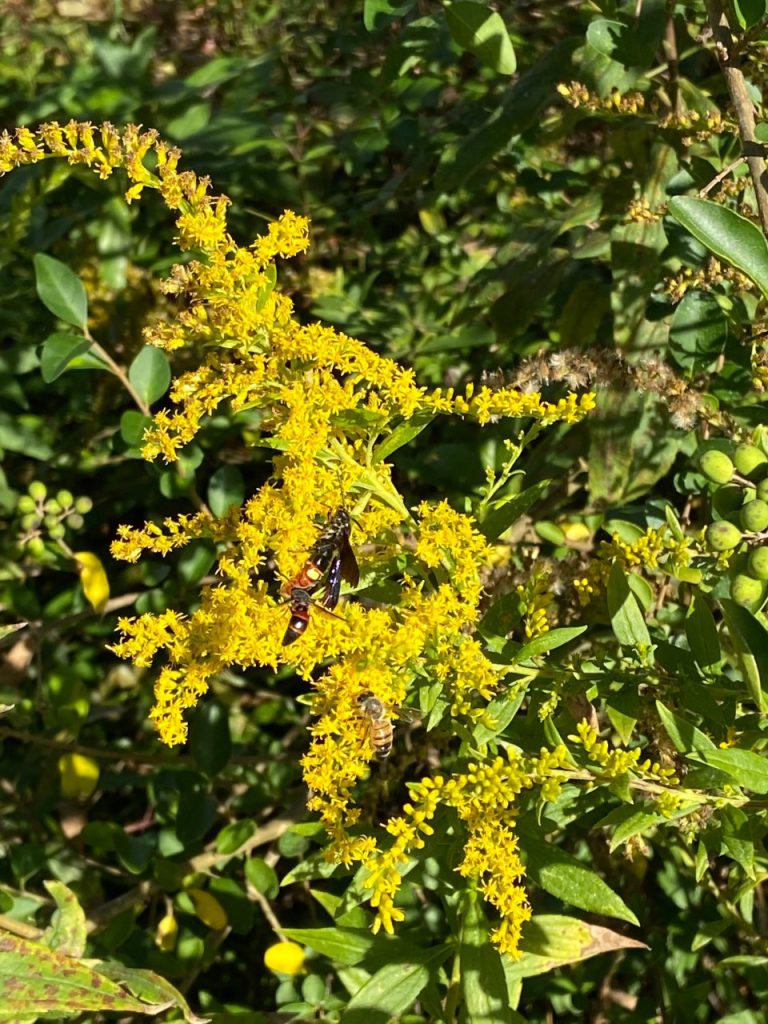
Golden Rod (Solidago spp.). Photo Courtesy Stephen Greer, University of Florida/IFAS Extension – Santa Rosa County
Golden Rod
One of the stronger colors of fall is yellow and the native Golden Rod is a big contributor with its upright stems holding multi-clusters of small bright yellow blooms. This plant serves as a pollinator plant for butterflies, bees and other beneficial insects. Often associated with fall allergies, this plant is not likely the culprit as the pollen is heavy and does not blow on the wind as ragweed will do. Ragweed blooms around the same time and does not have a showy bloom, yet many suffer from allergic reactions to this plant making it the likely problem plant for allergy sufferers. Golden Rod tends to colonize and crowd out other native plants so don’t hesitate to thin out the plant area if it is expanding too quickly.
Growing native plants including fall flowering selections is a fun journey for all to enjoy as the cool hints of fall weather moves in. Do a little research and keep in mind there is an Extension office in every county to assist in addressing your gardening needs.
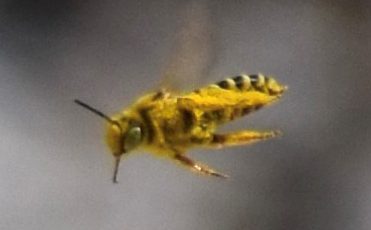
by Carrie Stevenson | Oct 28, 2021
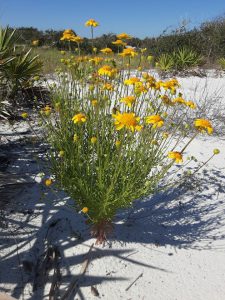
Coastal plain honeycombhead blooms through the summer and early fall on local beaches. Photo credit, Bob Pitts, National Park Service
Over my years of leading people on interpretive trail hikes, I have learned it is particularly important to know the names of the plants that are in bloom. These flowers are eye-catching, and inevitably someone will ask what they are. In fact, one of my favorite wildflower identification books is categorized not by taxonomy, but by bloom color—with a rainbow of tabs down the edge of the book for easy identification.
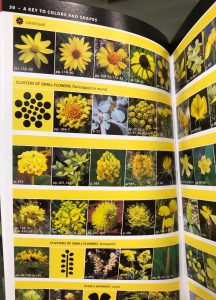
Wildflower identification can be tough, but color-coded guidebooks are really helpful! Photo credit: Carrie Stevenson, UF IFAS Extension
In our coastal dunes right now, several plants are showing off vibrant yellow blooms. Seaside goldenrod, coreopsis, and other asters are common. Rarer, and the subject of today’s post, is the Coastal Plain Honeycombhead (Balduina angustifolia). It has bright yellow flowers, but often gets more notice due to its unusual appearance when not in bloom. The basal leaves are bright green and similar in shape and arrangement to a pine cone or bottlebrush (albeit a tiny one), sticking straight up in the sand. The plants are typically found on the more protected back side of primary dunes or further into secondary dunes, a little more inland from the Gulf.
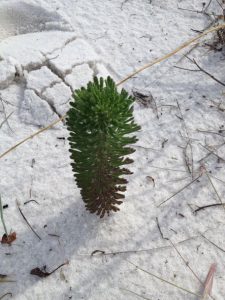
When not in bloom, the plant resembles a green pinecone planted in the sand. Photo credit: Carrie Stevenson, UF IFAS Extension
The plant plays a special role in beach ecology, as a host plant for Gulf fritillary butterflies and the Gulf Coast solitary bee (Hesperapis oraria). The bee is a ground-dwelling pollinator insect that forages only in the barrier islands of Mississippi, Alabama, and Florida. The species is currently the subject of a University of Florida study, as the endemic bee’s sole source of nectar and pollen is the honeycombhead flower. As of publication date, no bee nests have been discovered. Researchers are interested in learning more about the insect’s life cycle and nesting behaviors to better understand and protect its use of local habitats. Based on closely related species, it is believed the Gulf Coast solitary bee builds a multi-chambered nest under the soft sands of the dunes.
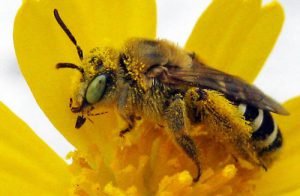
Adult female Hesperapis oraria foraging on coastal plain honeycombhead (Balduina angustifolia). Photograph by John Bente, Florida Department of Environmental Protection, Florida Park Service.
While the honeycombhead plant is found in peninsular Florida and coastal Georgia, the bee has been identified only in a 100 km² area between Horn Island, MS, and St. Andrews Bay, FL. Luckily for the bee, large swaths of this land are preserved as part of Gulf Islands National Seashore and several state parks. Nonetheless, these coastal dune habitats are threatened by hurricanes, sea level rise, and development (outside the park boundaries). Due to its rarity and limited habitat, a petition has been submitted to the Fish and Wildlife Service for protection under the Endangered Species Act.




















